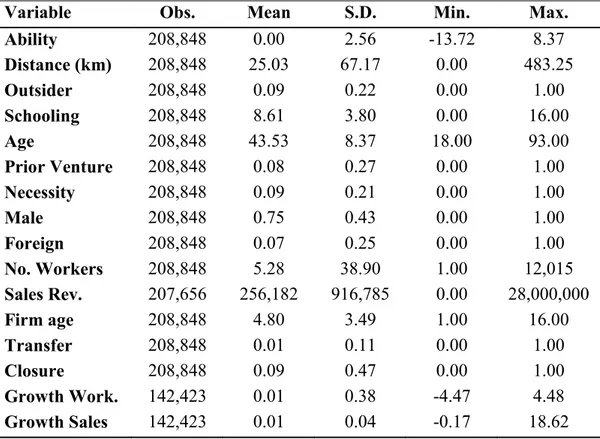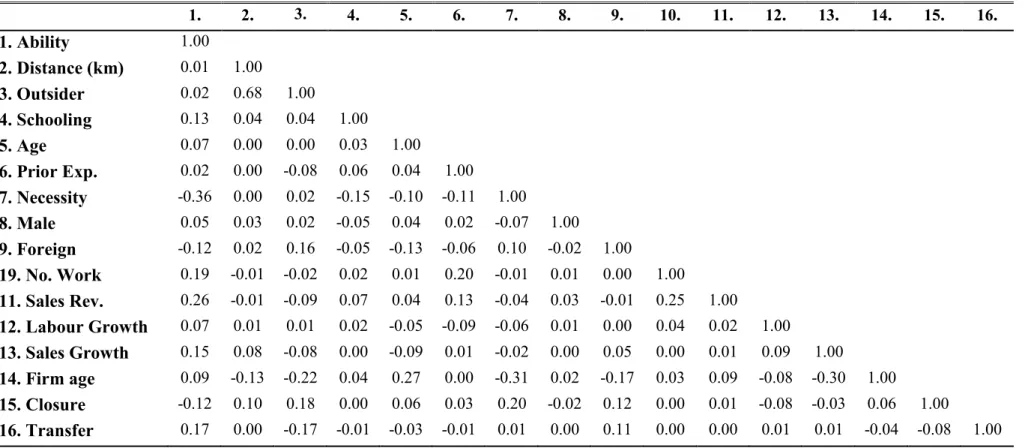Nova School of Business and Economics
Universidade Nova de Lisboa
Thesis submitted as part of the requirements for the Degree of Doctor of Philosophy in Management
The Role of Individual Ability and Structural Embeddedness on
Entrepreneurial Success
Bernardo M. Pimentel
A Thesis carried out under the supervision of Professor José Mata
February 4, 2015.
Table of Contents
I. Abstract ... 4
II. Introduction ... 5
III. Survey of the Literature ... 8
A. Entrepreneurial Ability ... 8
B. Structural Embeddedness... 20
IV. Hypotheses ... 26
A. Firm Performance ... 26
B. Continue, Transfer, or Close ... 32
C. Entrepreneurial Specialisation ... 37
V. Data and Methods ... 40
A. Data ... 40
B. Methods ... 53
VI. Results ... 62
A. Prior Productivity as Worker ... 62
B. Performance of Entrepreneurial Ventures... 64
C. Decision to Continue, Transfer, or Close ... 72
D. Entrepreneurial Specialisation ... 76
VII. Conclusions ... 82
A. Discussion ... 82
B. Limitations and Paths for Future Research ... 84
C. Final Remarks ... 86
D. Acknowledgements ... 87
I. Abstract
In the present thesis I analyse the roles of individual ability and structural
em-beddedness on entrepreneurial success. The results retrieved from a matched
employer-employee longitudinal data set show prior worker productivities and
environmental embeddedness to have a persistent positive impact on the size
and growth rates of new firms. What is more, embeddedness facilitates the
im-pact of ability on start-up performance with outsiders of comparable abilities
starting smaller and slower growing firms. Those in higher ability categories
are more likely to transfer and also, albeit to a lesser extent, close their
ven-tures, an effect attributed to the higher opportunity costs associated with the
group. Firms managed by embedded agents enjoy longer longevities and have
better chances of finding a new owner after the departure of the previous one.
Finally, higher ability types show evidence of specialisation in serial
entrepre-neurship.
(Keywords: entrepreneurship; individual ability; structural embeddedness; division of
labour)
“For he is Odysseus, a man of great craft, son of Laertes born in rugged Ithaca, and
ex-cels in all manner of tactics and subtle mētis”
Homer, Book III of the Iliad
II. Introduction
Mētis is an Ancient Greek word that denotes a quality of skill or cunning. It was the
de-fining trait of Odysseus, a character introduced by Homer in the Iliad and the hero of the
later Odyssey. Odysseus is a man of cunning who will take all necessary measures to
guarantee the success of his endeavours. By deceiving the Trojan with the gift of a giant
wooden horse, Odysseus was able to sneak into the citadel and overcome a larger force
than his own. Odysseus used whatever scarce resources he had at his disposal to great
effect, often by spotting an opportunity where others saw but a deadlock. Whilst the
con-temporary reader may be estranged by such a take on heroism, the conception of mētis
was in fact deeply rooted in Classic Greek tradition. Alexander the Great, for example, is
credited with solving the Gordian knot riddle by simply cutting it with his sword. Greek
heroes were not necessarily the bravest or the wisest. What they achieved however, was
unique and that was what distinguished them from their peers.
The previous analogy offers a brief description of one of the traits most
common-ly associated with the figure of the entrepreneur. The notion that entrepreneurs play
unique role in an economy can be traced back to Cantillon (1755) and has over time
re-ceived attention from scholars in various fields. Whilst contributions inspired mainly by a
disequilibrium approach to entrepreneurship emphasised the importance of the ability to
discover and create business opportunities (Schumpeter, 1934; Schultz, 1975; Casson,
differences in ability affected occupational choices leading to entrepreneurship and the
resulting individual and firm outcomes (Lucas, 1978; Casson, 1982; Amit et al., 1995;
Hamilton, 2000)
1. Holmes and Schmitz (1990) showed that individuals with greater
lev-els of ability to identify opportunities had a comparative advantage in specialising in
seri-al entrepreneurship whilst Gimeno et seri-al. (1997) explained the subsistence of
underper-forming firms with the relatively lack of employment alternatives for their owners.
However, the effect of ability on firm outcomes can also be conditioned by the
ex-isting degree of embeddedness between the entrepreneur and the business environment.
Firm internationalisation literature has long identified a liability of foreignness effect
(Zaheer, 1995) that hampers the performance of otherwise competitive newcomers into a
market. More recent contributions (Johanson and Vahlne, 2009) have generalised this
finding to all outsiders to a given environment and Figueiredo et al. (2002) found a strong
preference for entrepreneurs to start a new firm in areas where they had previously
worked.
In this thesis I assess how ability and embeddedness affect the outcomes of new
ventures and of their founders. Using a longitudinal data set with detailed information of
both individual and firm characteristics, I explore how past productivities of individuals
as wage-earners impact upon entrepreneurial outcomes and decisions. The distances
be-tween geographic locations of the workplaces of those individuals before and after the
beginning of their first self-employment spell serve as a proxy for embeddedness and also
constitute a determinant of firm performance, longevity, and transfer.
Results confirm the presence of a lasting interconnection between past
productivi-ties and the performance of subsequently created firms, with ventures created by superior
1 Whilst acknowledging the literature based on the risk preferences of the entrepreneur developed from the early

